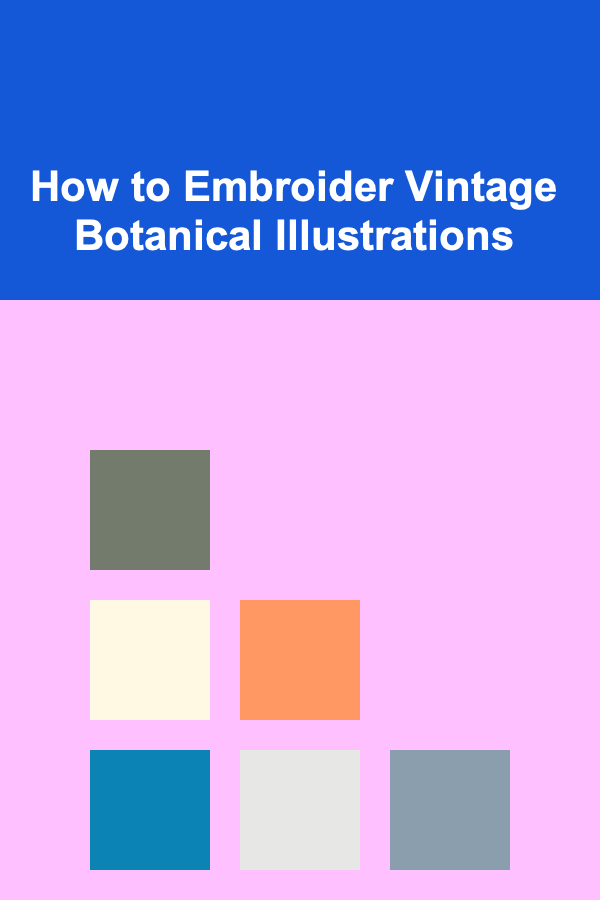
How to Embroider Vintage Botanical Illustrations
ebook include PDF & Audio bundle (Micro Guide)
$12.99$7.99
Limited Time Offer! Order within the next:

Embroidery is an ancient craft that has been passed down through generations, encompassing various techniques and styles. Among the many different forms of embroidery, vintage botanical illustrations have emerged as a timeless and elegant design choice. These detailed and intricate floral designs bring a touch of nature into the art of embroidery, offering an opportunity for both beginners and seasoned embroiderers to create stunning, nature-inspired works of art.
In this article, we will explore how to embroider vintage botanical illustrations, providing step-by-step instructions, tips, and techniques to guide you through the process. Whether you're looking to add a vintage flair to your collection or simply wish to immerse yourself in the beauty of botanical designs, this guide will equip you with the knowledge to create your own beautiful embroidered illustrations.
Choosing the Right Materials
Before you begin any embroidery project, it's important to select the right materials. For vintage botanical illustrations, the goal is often to achieve a refined and detailed finish, so quality materials are essential.
Fabric
The type of fabric you choose plays a crucial role in the overall outcome of your embroidery. For vintage botanical designs, natural fabrics such as linen or cotton work best due to their texture and ability to hold intricate stitches. Linen, with its subtle sheen and fine weave, is especially ideal for vintage-inspired designs.
- Linen: Offers a slightly textured surface that mimics the traditional fabric used for botanical illustrations.
- Cotton: Smooth, versatile, and easy to work with for beginners.
- Aida Cloth: Commonly used for cross-stitch but works well for botanical designs requiring precision.
Embroidery Threads
The choice of thread will depend on the look you're going for, but silk or cotton embroidery threads are commonly used for vintage botanical illustrations. These threads come in a variety of colors, allowing you to replicate the shades and textures found in vintage botanical prints.
- Cotton: Offers a matte finish and is widely available in numerous colors.
- Silk: Gives a soft, glossy finish and a luxurious look to your work.
- Variegated Threads: For a more intricate touch, variegated threads can create beautiful color gradients within the design.
Needles
Select needles that are appropriate for your fabric and thread. For fine, detailed work, a small, sharp needle such as a size 7 or 9 embroidery needle will ensure precise stitching. If you're using thicker threads, opt for a larger needle to avoid damaging the fabric.
Hoops
A wooden or plastic embroidery hoop helps keep the fabric taut while you work, which is especially important when you're creating delicate details found in vintage botanical illustrations. A well-stretched fabric ensures even stitching and smoother finishes.
Finding Vintage Botanical Illustrations
Vintage botanical illustrations are often found in botanical books, historical archives, and online image libraries. Websites such as the Biodiversity Heritage Library, public domain archives, or Pinterest often offer vintage plant illustrations that are free to use and download.
When selecting an illustration to embroider, consider the following factors:
- Complexity: Choose an illustration that suits your skill level. More intricate designs may require advanced techniques, while simpler ones are great for beginners.
- Size: If you're new to embroidery, start with a smaller design. Larger illustrations can be time-consuming but provide more room for detail and creativity.
- Composition: Look for designs with clear, defined lines, especially if you're aiming for a realistic effect. Simple illustrations with a focus on leaves, flowers, and stems often work best for botanical embroidery.
Once you've selected a botanical illustration, print it in the desired size. You can print it directly onto fabric or transfer the design using tracing paper or a lightbox.
Transferring the Design to Fabric
Transferring your botanical illustration onto fabric is a crucial step in embroidery. Here are several methods you can use to achieve a clean and accurate transfer:
Tracing with a Lightbox
If you're using thin, translucent fabric such as linen, a lightbox is a helpful tool. Place the fabric over the lightbox, then position the printed botanical illustration on top. The light from the box will illuminate the design, allowing you to trace it directly onto the fabric using a fabric marker or pencil.
Using Transfer Paper
Transfer paper allows you to transfer an illustration directly onto fabric using heat. Place the transfer paper between the fabric and the printed design. Then, iron over the design with a hot iron to transfer the lines onto your fabric.
Hand Tracing
For darker fabrics, or if you prefer a more hands-on approach, you can use carbon paper or a water-soluble pen to trace the design directly onto the fabric. Be sure to use a light hand when tracing to avoid pressing too hard and distorting the design.
Choosing Embroidery Stitches for Botanical Designs
Vintage botanical illustrations often include intricate details, which means selecting the right embroidery stitches to mimic those details is important. Below are some of the most commonly used stitches in botanical embroidery, along with tips on how to use them to achieve vintage-inspired looks.
Satin Stitch
The satin stitch is great for filling in areas of the design with solid color. Use this stitch to fill in petals, leaves, or any part of the illustration that requires a smooth, even surface.
- How to Do It: Bring the needle up at one end of the shape, then insert it at the other end, working your stitches close together to fill the space.
Stem Stitch
The stem stitch is ideal for outlining and creating delicate, natural-looking stems and branches in botanical illustrations. This stitch creates a slightly twisted effect that resembles the texture of plant stems.
- How to Do It: Insert the needle at the starting point, then bring it out a small distance away. Pull the thread tight to form a smooth, twisted line.
French Knots
French knots are perfect for adding texture to the center of flowers or for creating tiny details in your botanical design. These knots add dimension to your embroidery and work well for fine details.
- How to Do It: Wrap the thread around the needle two to three times, then insert the needle back into the fabric next to the starting point.
Lazy Daisy Stitch
This stitch is often used to create petal shapes in flowers. It gives the petals a soft, rounded look, making it ideal for creating vintage-style flowers with an elegant touch.
- How to Do It: Bring the needle up through the fabric, create a loop, and then insert the needle back into the fabric at the base of the loop. Repeat to form a daisy pattern.
Long and Short Stitch
Long and short stitches are perfect for shading and adding depth to your botanical illustrations. Use this technique to create smooth gradations of color, especially for petals and leaves.
- How to Do It: Start with long stitches, then fill in gaps with shorter stitches. Alternate between the lengths to create a blended effect.
Chain Stitch
The chain stitch is great for outlining the contours of plants, vines, and flowers. It gives a beautiful textured border, which is perfect for vintage botanical designs.
- How to Do It: Form loops along the fabric, making sure each loop is connected to the next.
Creating Shading and Depth
One of the defining features of vintage botanical illustrations is the use of shading to add depth and dimension. You can achieve a similar effect with embroidery by layering different stitches and thread colors.
- Gradation of Color: Use darker shades of thread near the base of petals or leaves, and lighter shades towards the edges to mimic natural lighting and shadow.
- Layering Stitches: Combine long and short stitches with satin stitch to add texture and depth, especially in areas where light and shadow would naturally fall.
Final Touches and Framing Your Work
Once you've finished the embroidery, it's time to add the final touches and display your work. Here are some tips to ensure your embroidered vintage botanical illustration looks polished:
Clean the Fabric
Before framing or displaying your embroidery, gently wash the fabric to remove any chalk or pen marks. You can also lightly steam the fabric to remove any wrinkles, but avoid direct contact with the stitches.
Framing Your Embroidery
For a vintage look, choose a wooden frame with a classic design. You can also add a fabric backing for a clean and finished appearance. Be sure to stretch the fabric taut in the frame to avoid any wrinkles or sagging.
Conclusion
Embroidering vintage botanical illustrations is a rewarding and creative endeavor that allows you to bring the beauty of nature into the art of embroidery. With the right materials, stitches, and techniques, you can create stunning botanical pieces that reflect the intricate designs of vintage plant illustrations. Whether you're new to embroidery or an experienced enthusiast, the process is a fulfilling way to explore both the artistic and technical sides of this beloved craft.
By following this guide, you'll be able to create intricate, nature-inspired works of art that not only showcase your skill but also bring timeless beauty into your home. Happy stitching!
Reading More From Our Other Websites
- [Organization Tip 101] How to Organize Essential Oils by Use and Purpose
- [Personal Care Tips 101] How to Use a Gua Sha Tutorial for Facial Sculpting and Lymphatic Drainage
- [Organization Tip 101] How to Maintain a Tidy Car with Smart Storage Solutions
- [Trail Running Tip 101] Running Wild: Transform Your Mindset with Trail Running for a Clean Slate
- [Organization Tip 101] How to Organize Your Children's Artwork and Projects
- [Home Cleaning 101] How to Tidy Up Your Home in 10 Minutes Each Morning
- [Home Budget 101] How to Save Money on Home Maintenance and Repairs
- [Organization Tip 101] How to Cut Down on Utility Bills with Smart Planning
- [Home Soundproofing 101] How to Soundproof a Home for Sensitive Ears (e.g., Autism)
- [Personal Care Tips 101] How to Find and Use Sustainable Dental Care Products

How to Create a Retirement Planning Checklist for Managing Debt Before Retirement
Read More
How to Store and Protect Your Holiday Decorations
Read More
How to Use Over-the-Door Organizers for Extra Storage
Read More
Maximize Your Learning: Free or Low-Cost Educational Resources for Students
Read More
10 Tips for Maintaining Your Aircraft's Engine
Read More
How to Manage Football Team Dynamics and Morale
Read MoreOther Products

How to Create a Retirement Planning Checklist for Managing Debt Before Retirement
Read More
How to Store and Protect Your Holiday Decorations
Read More
How to Use Over-the-Door Organizers for Extra Storage
Read More
Maximize Your Learning: Free or Low-Cost Educational Resources for Students
Read More
10 Tips for Maintaining Your Aircraft's Engine
Read More